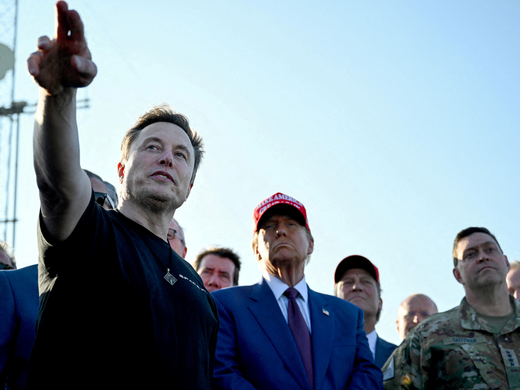In 1909, Guglielmo Marconi and Ferdinand Braun shared a Nobel Prize in Physics for developing a new communications technology: wireless telegraphy.1 This technology enabled people to send messages through the ether without physical telegraph cables. It was widely used to send information well into the mid-twentieth century. It also represented a major step toward what would become spoken radio in the 1920s.
Marconi was an Italian entrepreneur based in the United Kingdom (Raboy 2016). Braun was a German physicist. At the same time as the two men shared a Nobel Prize, the countries in which they lived were competing over the communications technology that they had helped to create. In 1902, the British government had finished laying what they called an “All-Red Route” of undersea cables around the world that only landed on British imperial and colonial soil. British officials knew about wireless but found it less secure and trustworthy than their extant cable network.
Meanwhile, though, the German government was subsidizing research and development into wireless technology because it wanted to bypass the British cable system. German officials increasingly believed that the British were using and abusing their cable network to censor and control the information sent through it. For many Germans, wireless technology offered the promise of removing dependence on British cables. Scientific advances and geopolitical competition were occurring simultaneously. None of this would end well: half a decade later, World War I broke out.
This history may seem far away and long ago. But it raises broader questions about digital platforms, their regulation and what the history tells us. Too often, we neglect the role of infrastructure in platform regulation. In this essay, I suggest several crucial lessons from the history of communications infrastructure. First, infrastructure is incredibly path-dependent, meaning that the history of infrastructure has fundamentally shaped digital connections in the present. Second, there are examples from the past of both international cooperation and competition over infrastructure. Sometimes, competition over infrastructure has led to infrastructural warfare. At other times, careful brokering has led to new institutions and cooperation. Rather than make simplistic analogies to past situations, we can tease out what institutions, geopolitical contexts and regulatory initiatives may enable cooperation. Finally, the history highlights how international regulation depends on how politicians and officials understand their relationship to new technologies.
Over the last three to four years, there has been an efflorescence of regulatory initiatives being enacted or contemplated around the world. These range from data privacy regulation such as the General Data Protection Regulation in the European Union to agreements over payments for news in Australia to antitrust enforcement action in China to tax agreements. As Ronaldo Lemos and Christian Perrone point out in their essay, almost all of these efforts face a paradox. They are trying to regulate locally technologies that were created to be border-crossing and global. Those dynamics also extend to the infrastructure underlying digital platforms.
While the internet has reached proportionally more people on the planet than any other previous technology, its reach still rests on prior infrastructural patterns stretching back at least to the nineteenth century. These infrastructures emerged during a time of violent imperialism, with roads, rails and telegraphs built to serve colonial needs, not the local population. As many scholars have shown, infrastructure is particularly path-dependent (Parks and Starosielski 2015). Whether they use railroads or undersea cables, governments and companies tend to use the same spaces to lay new connections. This perpetuates existing inequalities, both locally and globally (Rossmann and Cohen 2021).
Submarine cables are a classic example. The first submarine cable was laid between the United Kingdom and France in 1851. After two failed attempts, a durable transatlantic cable was finished in 1866. Cables spread rapidly around the globe. But they followed specific patterns. Instead of connecting previously unconnected places, they created denser networks where networks already existed, such as across the Atlantic. The major company laying cables was a conglomerate, the Eastern and Associated Telegraph Companies, headquartered in London, England (Müller 2016). Operating transatlantic cables made telegraph companies “some of the most lucrative contemporary multinationals” in the late nineteenth century (Müller and Tworek 2015, 260). Cables made the most money when they connected places that already traded with each other. Only in the early 1900s did governments subsidize cables across the Pacific to create new connections. The two cables laid across the Pacific from the West Coast to Asia failed to create new markets and lost money. The British-subsidized cable was laid to complete the All-Red Route for geopolitical reasons. It turned out that “political ambition and geopolitical rivalries proved less successful motives for cables than commercial imperatives” (ibid., 272).
Although submarine telegraph cables are long defunct, they set precedents for later communications networks, such as telephone cables and fibre-optic internet cables (Starosielski 2015). Cables were generally laid on ocean beds that had already been sounded, as this saved money. This also followed the pattern of laying cables where proven markets already existed. Fibre-optic internet cable networks resembled submarine cable networks until very recently.
These precedents are crucial to comprehend our contemporary digital platforms, which build on existing infrastructure. The internet may seem wireless, but fibre-optic cables carry 95 to 99 percent of international data. Our current seemingly global communications infrastructures had imperial roots. Telegraph companies laid many fewer cables to Africa, for instance, because managers believed that there would be fewer high-paying clients. The British All-Red-Route cable only landed in South Africa on the entire African continent. Other cables spread up the coasts but with far less density than across the Atlantic. This has had long-lasting consequences, making it costlier and harder to lay cables to and around Africa.
Perhaps unsurprisingly, platform giants have become crucial players in infrastructure too, though with much less fanfare and contestation than over content provision. Google partly owns 8.5 percent of all fibre-optic submarine cables (Cooper 2018). Just like the Eastern and Associated Telegraph Companies eventually expanded to Africa, so too are Facebook and Google. Both are in the process of laying cables to Africa to expand the number of Africans with internet access (Kazeem 2019). Google and Facebook aim to increase the capacity of cables to Africa, lower the cost and massively increase the market for their products.
At the same time, African nations now have more choices than US-based companies. Chinese firm Huawei constructed approximately 70 percent of Africa’s fourth-generation connections (Mackinnon 2019). This builds on decades of Chinese provision of railroad and other infrastructure to Africa. For example, the Tazara Railway was constructed in the 1970s to link the Zambian copper belt to the Indian Ocean; the Chinese handed over the railway to Tanzania and Zambia in 1976 (Monson 2013). Internet infrastructure, of course, forms part of the current Belt and Road Initiative’s infrastructure vision. And it comes with potential costs: some alleged that Huawei had bugged the African Union’s headquarters that were built by Chinese companies. Still, Emeka Umejei from the American University of Nigeria noted in 2019 that “most policymakers and politicians in Africa, they don’t really care” about those allegations. Umejei called Africa “a pawn on the global chessboard in the ongoing geopolitical context” (Mackinnon 2019). Others would contest that African nations are also exercising their own agency in choosing between American and Chinese companies (Gagliardone, forthcoming 2022). Regardless of the interpretation, these examples highlight that regulatory discussions around platforms cannot ignore platforms’ and states’ involvement in internet infrastructure.
If we account for infrastructure, we might follow C. Randall Henning’s suggestion to improve collaboration by specifying “areas in which competition is acceptable” (Henning 2021, 5). Many places around the world find themselves in similar situations to African nations. Will they work with China-based internet infrastructural firms such as Huawei or US-based firms such as Apple, Google or Facebook? Or will they work with both? One way to think through these problems on a global scale is to look back in time to two examples of previous infrastructures. In the instance of international telegraphy in the 1850s, states found a way to cooperate peacefully for decades. From the 1890s, however, they did not.
In the 1850s, landline telegraphic cables were spreading like wildfire across the European continent. But there were two competing technical systems that were incompatible. France and some other Western European countries wanted one technical standard, while the Habsburg Empire and some other Central European countries wanted another. If the two groupings could not agree, telegraphy across borders would become very expensive and difficult, if not impossible.
Switzerland inserted itself into this contentious situation and brokered a compromise solution. The Swiss also suggested that an international organization was necessary to facilitate continuing dialogue around telegraphic infrastructure and to prevent future conflicts. This led to the creation of the first major international organization: the International Telegraph Union (ITU) in 1865. After Switzerland’s successful facilitation, it was rewarded with hosting the headquarters of the organization in Berne (Balbi et al. 2014).
The ITU offered membership to states. But it also allowed major submarine cable companies to send representatives to meetings. The organization met regularly and brokered various technical agreements between members around international communications. Despite other geopolitical rivalries (and even war between some member states), the ITU reached a major agreement around international telegraphy in St. Petersburg, Russia, in 1875. (NB the major drawback to this agreement is that it did not regulate communications during times of war.)2 There were surprisingly few complaints about the oligopolistic structure of submarine telegraphy, in part, because colonized peoples could not send representatives to the ITU. States were not caught between different systems because technical issues were generally regulated within the ITU.
Despite this prior experience, things did not pan out peacefully from the 1890s onward for cables or wireless. Different attitudes to technology and to geopolitics began to prevail. Prior to the 1890s, most states were satisfied with the submarine cable system and saw it as a neutral conduit of information. As international competition began to heat up between countries such as Britain and Germany, both states started to see cables as an arena of geopolitical competition. Many states worried that states might surveil cables or content or cut cables if a war broke out.
British and German officials’ different strategies emerged from different attitudes toward technology. As historian Bernhard Rieger has argued for this period, the British often saw technologies as “instruments to stabilize an international status quo favourable to their nation, while Germans viewed products of engineering as tools to transform the international environment that stifled their political ambitions” (Rieger 2005, 18). By 1914, the German government had subsidized a wireless route around the world to bypass the British All-Red Route of cables. The British remained invested in cables.
When World War I broke out, one of the first British acts of war was to cut all but one of the cables connecting German communications to the outside world. Then, some of the Allies’ first battles outside Europe captured territories with German wireless towers to destroy that network. The Germans, meanwhile, retaliated by cutting British undersea cables throughout the war and interfering with their repair. The Germans sometimes even used a rheostat to emit false electrical signals about where the break in a submarine cable had occurred. This made it harder to repair the cables swiftly (Winkler 2009, 858).3 Infrastructural competition over new communications technologies all too quickly became infrastructural warfare.
Despite the massive coverage of fifth-generation networks and Huawei, discussions around regulating digital platforms all too rarely incorporate cable infrastructure into their overall vision. But infrastructure shapes content, business strategies and more. A Huawei subsidiary, Huawei Marine, has laid or repaired nearly 100 of the approximately 400 global submarine cables; Huawei sold the subsidiary to Hengtong in 2019, possibly due to the Trump administration’s blacklisting of Huawei (Solov 2019). Fibre-optic cable surveillance is clearly happening: Russia’s spy ship, the Yantar, has long possessed the capability to cut or tap cables (Sanger and Schmitt 2015). The early 1900s echo in the present. Or, more accurately, we see the continuation of techniques and priorities from that period, which many policy makers disregarded for decades.
History does not give a neat answer to how to regulate digital platforms today. But it tells us that infrastructure is a major part of the picture. Perhaps the 2020s are the new 1890s: states are reckoning with how other states might use infrastructure to censor, surveil and control content. But perhaps the 2020s are the 1850s: a moment when a nation such as Switzerland might broker a compromise, enabling infrastructural cooperation, a new international approach to regulation and new mechanisms for collaboration. Both of those scenarios, however, exclude many low- and middle-income countries; in the worst case, they disregard the path dependency that has led to the global inequalities in internet access we see today. It is up to us whether we recreate the 1850s, the 1890s or forge something completely different.



